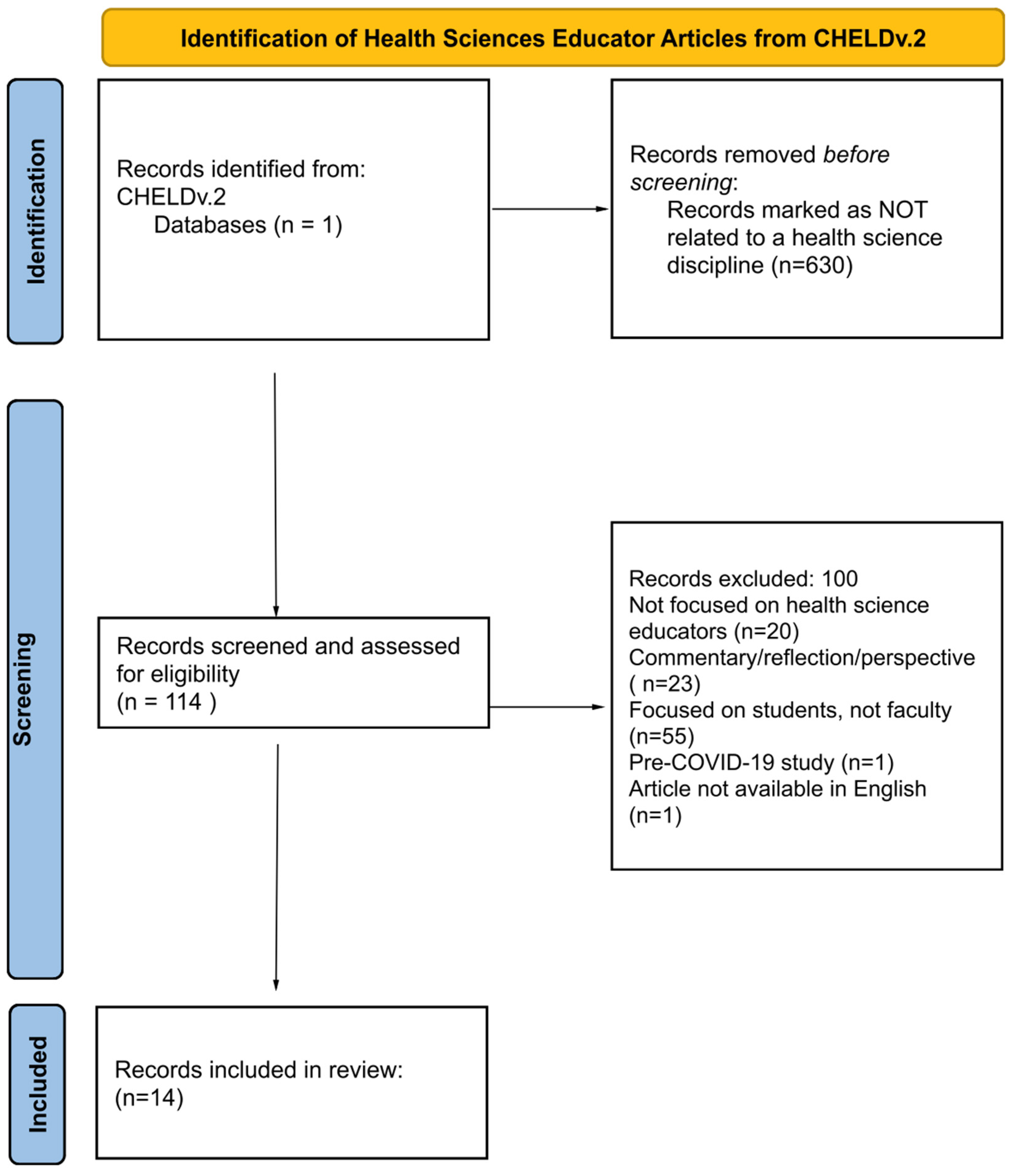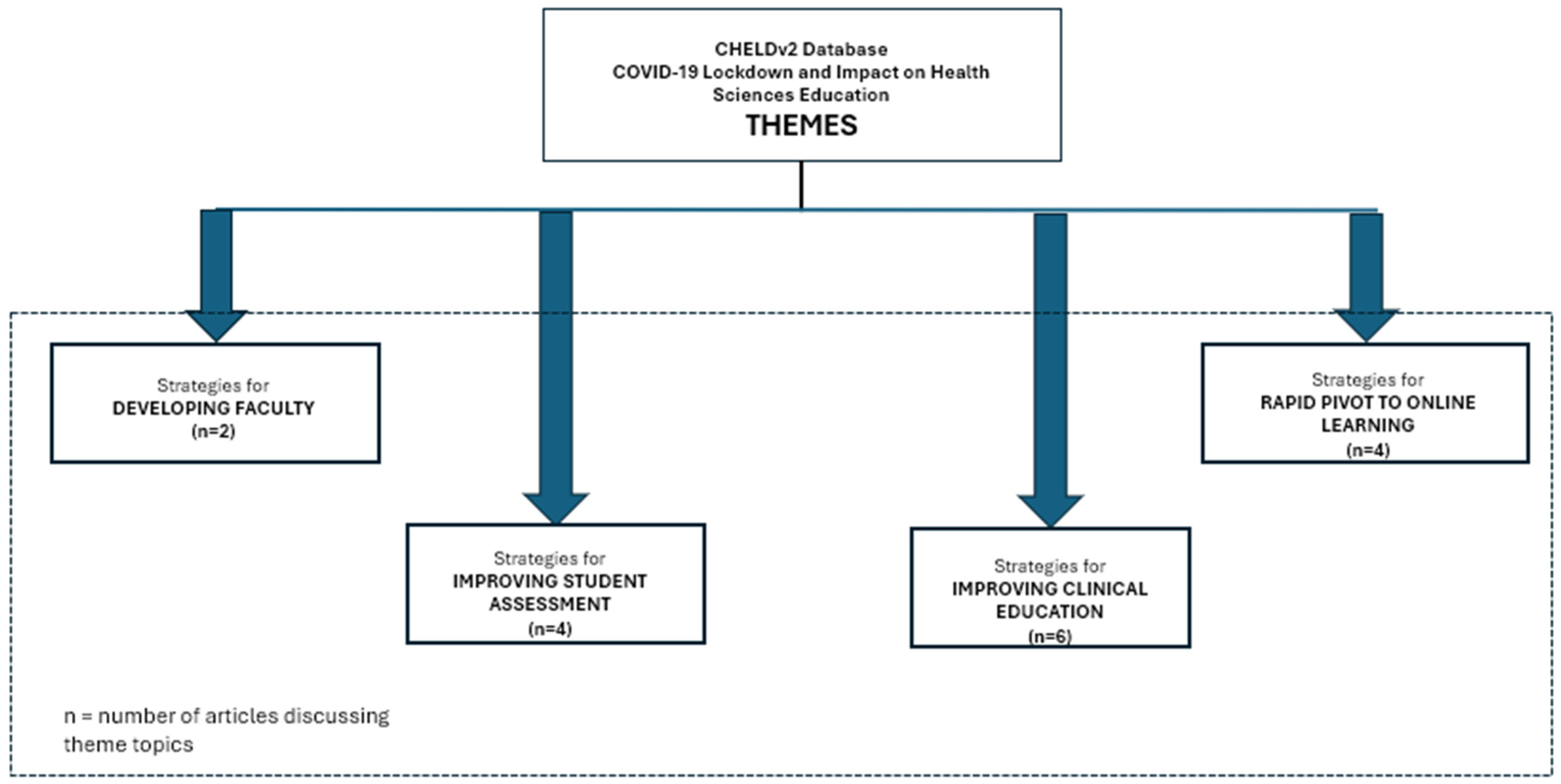Health Sciences Faculty’s Perceptions of Educational Changes During COVID-19: Global Lessons
Abstract
1. Introduction
2. Materials and Methods
2.1. Literature Search Strategy
2.2. Data Analysis
3. Results
4. Discussion
4.1. Strategies for Faculty Development
4.2. Strategies to Improve Student Assessment
4.3. Strategies to Improve Clinical Education Techniques
4.4. Strategies for the Rapid Pivot to Online Learning
4.5. Strengths and Limitations
4.6. Areas of Future Research
5. Conclusions
Author Contributions
Funding
Institutional Review Board Statement
Informed Consent Statement
Data Availability Statement
Conflicts of Interest
References
- Crawford, J.; Butler-Henderson, K.; Lalani, K.; Rudolph, J.; Sabu, K. Initial crisis leadership during COVID-19 higher education: A systematic review. Technol. Pedagog. Educ. 2024, 1–17. [Google Scholar] [CrossRef]
- Goh, P.S.; Sandars, J. A vision of the use of technology in medical education after the COVID-19 pandemic [version 1]. MedEdPublish 2020, 9, 49. [Google Scholar] [CrossRef] [PubMed]
- Bastos, R.A.; Carvalho, D.R.; Brandao, C.F.S.; Bergamasco, E.D.; Sandars, J.; Cecilio-Fernandes, D. Solutions, enablers and barriers to online learning in clinical medical education during the first year of the COVID-19 pandemic: A rapid review. Med. Teach. 2022, 44, 187–195. [Google Scholar] [CrossRef]
- Abdull Mutalib, A.A.; Akim, A.M.; Jaafar, M.H. A systematic review of health sciences students’ online learning during the COVID-19 pandemic. BMC Med. Educ. 2022, 22, 524. [Google Scholar] [CrossRef]
- Butler-Henderson, K.; Tan, S.; Lalani, K.; Karakka Mandapam, S.; Kemp, T.; Rudolph, J.; Crawford, J. Update of the COVID-19 in Higher Education Literature Database (CHELD) Version 2. J. Appl. Learn Teach. 2021, 4, 134–137. [Google Scholar] [CrossRef]
- Braun, V.; Clarke, V. Using thematic analysis in psychology. Qual. Res. Psychol. 2006, 3, 77–101. [Google Scholar] [CrossRef]
- Eltayar, A.N.; Eldesoky, N.I.; Khalifa, H.; Rashed, S. Online faculty development using cognitive apprenticeship in response to COVID-19. Med. Educ. 2020, 54, 665–666. [Google Scholar] [CrossRef]
- O’Keefe, L.; Rafferty, J.; Gunder, A.; Vignare, K. Delivering high-quality instruction online in response to COVID-19: Faculty playbook. Every Learn Everywhere 2020. Available online: https://www.everylearnereverywhere.org/resources (accessed on 25 February 2025).
- Khalaf, K.; El-Kishawi, M.; Moufti, M.A.; Kawas, S.A. Introducing a comprehensive high-stake online exam to final-year dental students during the COVID-19 pandemic and evaluation of its effectiveness. Med. Educ. Online 2020, 25, 1826861. [Google Scholar] [CrossRef]
- Unnikrishnan, V.; Ansary, P.; Varghese, S. Online Teaching in Ayurveda Medical Education during COVID-19 Pandemic—A Descriptive Survey Study. Int. J. Ayurvedic Med. 2020, 11, 690–694. [Google Scholar]
- Schlenz, M.; Schmidt, A.; Wostmann, B.; Kramer, N.; Schulz-Weidner, N. Students’ and lecturers’ perspective on the implementation of online learning in dental education due to SARS-CoV-2 (COVID-19): A cross-sectional study. BMC Med. Educ. 2020, 20, 354. [Google Scholar] [CrossRef]
- Moszkowicz, D.; Duboc, H.; Dubertret, C.; Roux, D.; Bretagnol, F. Daily medical education for confined students during coronavirus disease 2019 pandemic: A simple videoconference solution. Clin. Anat. 2020, 33, 927–928. [Google Scholar] [CrossRef] [PubMed]
- Nagji, A.; Yilmaz, Y.; Zhang, P.; Dida, J.; Cook-Chaimowitz, L.; Dong, J.; Colpitts, L.; Beecroft, J.; Chan, T. Converting to Connect: A Rapid RE-AIM Evaluation of the Digital Conversion of a Clerkship Curriculumin the Age of COVID-19. AEM Educ. Train 2020, 4, 330–339. [Google Scholar] [CrossRef] [PubMed]
- Rashid, A.; Rashid, M.; Yaman, M.; Mohamad, I. Teaching Medicine Online During the COVID-19 Pandemic: A Malaysian Perspective. Bangladesh J. Med. Sci. 2020, 19, S77–S81. [Google Scholar] [CrossRef]
- Munoz-Leija, M.; Zarate-Garza, P.; Jacobo-Baca, G.; Quiroga-Garza, A.; Salinas-Alvarez, Y.; Martinez-Garza, J.; Elizondo-Omana, R.; Guzman-Lobez, S. Modifications to the delivery of a gross anatomy course during the COVID-19 pandemic at a Mexican medical school. Eur. J. Anat. 2020, 24, 507–512. [Google Scholar]
- Haridy, R.; Abdalla, M.; Kaisarly, D.; El Gezawi, M. A cross-sectional multicenter survey on the future of dental education in the era of COVID-19: Alternatives and implications. J. Dent. Educ. 2021, 85, 483–493. [Google Scholar] [CrossRef]
- Kawaguchi-Suzuki, M.; Nagai, N.; Akonoghrere, R.; Desborough, J. COVID-19 Pandemic Challenges and Lessons Learned by Pharmacy Educators Around the Globe. Am. J. Pharm. Educ. 2020, 84, ajpe8197. [Google Scholar] [CrossRef]
- Mehta, N.; End, C.; Kwan, J.; Bernstein, S.; Law, M. Adapting medical education during crisis: Student-Faculty parnerships as an enabler of success. Med. Teach. 2022, 44, 688–689. [Google Scholar] [CrossRef]
- Gomez, E.; Azadi, J.; Magid, D. Innovation Born in Isolation: Rapid Transformation of an In-Person Medical Student Radiology Elective to a Remote Learning Experience During the COVID-19 Pandemic. Acad. Radiol. 2020, 27, 1285–1290. [Google Scholar] [CrossRef]
- Rahim, A.; Ali, S.; Fayyaz, H. Online Education During COVID-19 Pandemic: An Experience of Riphah International University Faculty of Health and Medical Sciences. Pak. Armed Forces Med. J. 2020, 70, S506. [Google Scholar]
- Nabolsi, M.; Abu-Moghli, F.; Khalaf, I.; Zumot, A.; Suliman, W. Nursing Faculty Experience With Online Distance Education During COVID-19 Crisis: A Qualitative Study. J. Prof. Nurs. 2021, 37, 828–835. [Google Scholar] [CrossRef] [PubMed]
- Awadallah, N.; Czajac, A.; Fainstad, T.; McNulty, M.; Jaiswal, K.; Jones, T.; Rumack, C. The impact of the COVID-19 pandemic on family medicine residency training. Fam. Pract. 2021, 38, i9–i15. [Google Scholar] [CrossRef] [PubMed]
- Hebert, E.; Jeon, K.; Wood, R.; Reena, I.; Hey, W.; Hickey, S.; Noll, K.; Peevy, A.; Reynold, J.; Thomas, P. Studying U.S. college faulty during the COVID-19 pandemic: Perceptions of severity, concerns, sources of information, preventitive behaviors, barriers to work performance, and impacct on work productivity. Pedagog. Res. 2024, 9, em0175. [Google Scholar] [CrossRef]
- McNaughton-Cassill, M.; Lopez, S.; Cassill, A. What If the Faculty Are Not Alright? Burnout and Compassion Fatigue in Higher Education. Change Mag. High. Learn. 2023, 55, 23–34. [Google Scholar] [CrossRef]
- Bitter, A.; McCrea, S. “The ship is sinking, yet the band plays on”: COVID-19 and academia. J. Am. Coll. Health 2022, 72, 1876–1885. [Google Scholar] [CrossRef]
- Sevak, R.; Sanz, R.; Patel, R.; O’Dell, K. Impact of the COVID-19 Pandemic on US Pharmacy Academia Per Perspectives of Faculty and Administrators. Am. J. Pharm. Educ. 2024, 88, 100635. [Google Scholar] [CrossRef]
- Dehnad, A.; Abdekhoda, M. Mapping the Publications of e-learning during the COVID-19 Pandemic: A Bibliometric Analysis. J. Scientometr. Res. 2023, 12, 35–43. [Google Scholar] [CrossRef]
- Hameed, A.; Fakhir, S.; Ahmed, S. Implementation Plan and Solutions to the Challenges Faced by Medical Faculty During COVID-19 Pandemic: Transition to the New Normal. Pak. Armed Forces Med. J. 2022, 72, 1278–1282. [Google Scholar] [CrossRef]
- Reinhart, A.; Malzkorn, B.; Doing, C.; Beyer, I.; Junger, J.; Bosse, H. Undergraduate medical education amid COVID-19; a qualitative analysis of enablers and barriers to acquiring competencies in distant learning using focus groups. Med. Educ. Online 2021, 26, 1940765. [Google Scholar] [CrossRef]


Disclaimer/Publisher’s Note: The statements, opinions and data contained in all publications are solely those of the individual author(s) and contributor(s) and not of MDPI and/or the editor(s). MDPI and/or the editor(s) disclaim responsibility for any injury to people or property resulting from any ideas, methods, instructions or products referred to in the content. |
© 2025 by the authors. Licensee MDPI, Basel, Switzerland. This article is an open access article distributed under the terms and conditions of the Creative Commons Attribution (CC BY) license (https://creativecommons.org/licenses/by/4.0/).
Share and Cite
Lalani, K.; Karwaki, T.E.; Condon, J. Health Sciences Faculty’s Perceptions of Educational Changes During COVID-19: Global Lessons. Trends High. Educ. 2025, 4, 15. https://doi.org/10.3390/higheredu4010015
Lalani K, Karwaki TE, Condon J. Health Sciences Faculty’s Perceptions of Educational Changes During COVID-19: Global Lessons. Trends in Higher Education. 2025; 4(1):15. https://doi.org/10.3390/higheredu4010015
Chicago/Turabian StyleLalani, Karima, Tanya E. Karwaki, and James Condon. 2025. "Health Sciences Faculty’s Perceptions of Educational Changes During COVID-19: Global Lessons" Trends in Higher Education 4, no. 1: 15. https://doi.org/10.3390/higheredu4010015
APA StyleLalani, K., Karwaki, T. E., & Condon, J. (2025). Health Sciences Faculty’s Perceptions of Educational Changes During COVID-19: Global Lessons. Trends in Higher Education, 4(1), 15. https://doi.org/10.3390/higheredu4010015





